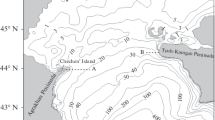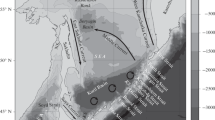Abstract
A numerical simulation has been undertaken to study the process of the transport of small river runoff by alongshore baroclinic sea currents. The study is based on the implementation of the Princeton Ocean Model (POM) under the conditions of a circular stratified basin whose surface is exposed to a transient tangential wind stress to form an alongshore baroclinic current. A baroclinic current of the downwelling type (in the Northern Hemisphere directed to the left to a sea-viewing observer) was shown to provide the carrying out of the river discharge from estuary’s vicinity more effectively than that of the upwelling type (in the Northern Hemisphere directed to the right to a sea-viewing observer).
Similar content being viewed by others
References
Hydrochemistry and Hydrometeorology of Seas of the USSR, Vol. IV: The Black Sea, Ed. by F. S. Terziev (Gidrometeoizdat, Leningrad, 1991), issue 1 [in Russian].
M. I. L’vovich, Water and Life (Mysl’, Moscow, 1986) [in Russian].
A. F. Blumberg and G. L. Mellor, “Diagnostic and Prognostic Numerical Calculation Studies of the South Atlantic Bight,” J. Geophys. Res. 88(C4), 4579–4592 (1983).
A. F. Blumberg and G. L. Mellor, “A Description of a Three-Dimensional Coastal Ocean Circulation Model,” in Three-Dimensional Coastal Ocean Models, Ed. by N. Heaps (Amer. Geophys. Union, 1987), pp. 1–16.
B.-J. Choi and J. L. Wilkin, “The Effect of Wind Dispersal of the Hudson River Plume,” J. Phys. Oceanogr. 37, 1878–1897 (2007).
D. A. Fong and W. R. Geyer, “The Alongshore Transport of Freshwater in a Surface-Trapped River Plume,” J. Phys. Oceanogr. 32, 957–972 (2002).
R. W. Garvine, “A Steady State Model for Buoyant Surface Plume Hydrodynamics in Coastal Waters,” Tellus 34, 293–306 (1982).
R. W. Garvine, “Estuary Plumes and Fronts in Shelf Waters: A Layer Model,” J. Phys. Oceanogr. 17, 1877–1896 (1987).
R. W. Garvine, “A Dynamical System of Classifying Buoyant Coastal Discharges,” Cont. Shelf Res. 15, 1585–1596 (1995).
R. W. Garvine, “Buoyant Discharge on the Inner Continental Shelf: A Frontal Model,” J. Marine Res. 54, 1–33 (1996).
W. R. Geyer, P. Hill, T. Milligan, and P. Traykovsky, “The Structure of Eel River Plume during Floods,” Cont. Shelf Res. 20, 2067–2093 (2000).
J. M. Hamrick, A Three-Dimensional Environmental Fluid Dynamics Computer Code: Theoretical and Computational Aspects. Report 317 (College of William and Mary, Virginia Institute of Marine Science, Williamsburg, Virginia, 1992).
A. K. Masse and C. R. Murthy, “Analysis of the Niagara River Plume Dynamics,” J. Geophys. Res. 97, 2403–2420 (1992).
G. L. Mellor and T. Yamada, “Development of a Turbulence Closure Model for Geophysical Fluid Problems,” Rev. Geophys. Space Phys. 20(4), 851–875 (1982).
A. Munchow and R. W. Garvine, “Dynamical Properties of a Buoyancy Driven Coastal Current,” J. Geophys. Res. 98, 20063–20078 (1993).
J. D. Nash and J. N. Moum, “River Plumes as a Source of Large-Amplitude Internal Waves in the Coastal Ocean,” Nature 437, 400–403 (2005).
J. D. Pullen and J. S. Allen, “Modeling Studies of the Coastal Circulation Off Northern California: Shelf Response to a Major Eel River Flood Event,” Cont. Shelf Res. 20, 2213–2238 (2000).
A. F. Shchepetkin and J. C. McWilliams, “The Regional Oceanic Modeling System (ROMS): A Split-Explicit, Free Surface, Topography-Following-Coordinate Oceanic Model,” Ocean Modeling 9, 347–404 (2005).
M. Xia, L. Xie, and L. J. Pietrafesa, “Modeling of the Cape Fear River Estuary Plume,” Estuaries Coasts 30(4), 698–709 (2007).
A. E. Yankovsky and D. C. Chapman, “A Simple Theory for the Fate of Buoyant Coastal Discharges,” J. Phys. Oceanogr. 27, 1386–1401 (1997).
A. E. Yankovsky, B. M. Hickey, and A. Munchow, “Impact of Variable Inflow on the Dynamics of a Coastal Plume,” J. Geophys. Res. 106, 19809–19824 (2001).
Author information
Authors and Affiliations
Corresponding author
Additional information
Original Russian Text © V.M. Zhurbas, P.O. Zavialov, A.S. Sviridov, D.A. Lyzhkov, E.E. Andrulionis, 2011, published in Okeanologiya, 2011, Vol. 51, No. 3, pp. 440–449.
Rights and permissions
About this article
Cite this article
Zhurbas, V.M., Zavialov, P.O., Sviridov, A.S. et al. On the transport of small river run off by an alongshore baroclinic sea current. Oceanology 51, 415–423 (2011). https://doi.org/10.1134/S0001437011030234
Received:
Accepted:
Published:
Issue Date:
DOI: https://doi.org/10.1134/S0001437011030234




